
Coelogyne is a genus of over 200 sympodial epiphytes from the family Orchidaceae, distributed across India, China, Indonesia and the Fiji islands, with the main centers in Borneo, Sumatra and the Himalayas. They can be found from tropical lowland forests to montane rainforests. A few species grow as terrestrials or even as lithophytes in open, humid habitats. The genera BolborchisLindl., HologynePfitzer and PtychogynePfitzer are generally included here. The genus is abbreviated Coel. in trade journals.
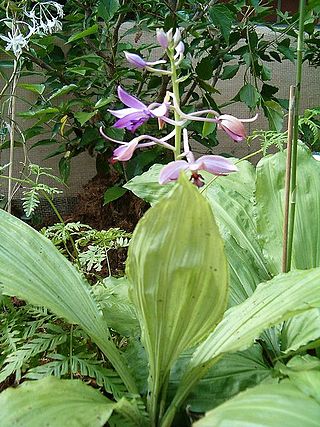
Calanthe, commonly known as Christmas orchids, is a genus of about 220 species of orchids in the family Orchidaceae. They are evergreen or deciduous terrestrial plants with thick roots, small oval pseudobulbs, large corrugated leaves and upright, sometimes arching flowering stems. The sepals and petals are narrow and a similar size to each other and the labellum usually has spreading lobes.

Laeliinae is a Neotropical subtribe including 40 orchid genera, such as Brassavola, Laelia and Cattleya. The genus Epidendrum is the largest within this subtribe, containing about 1500 species. This is followed by the genus Encyclia, with over 120 species.

Angraecopsis is a genus of plants in the family Orchidaceae. It was first described by Fritz Kraenzlin in 1900 and given its name on account with the genus' similarity to Angraecum species. Angraecopsis are native to Africa, Madagascar, Réunion, Mauritius and the Comoros. The growth habit is rather small and the leaves emerge from a woody stem.
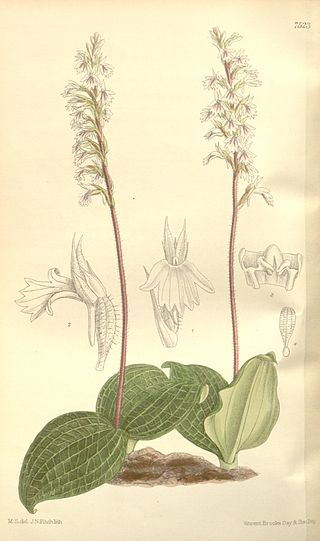
Holothrix is a genus of plants in family Orchidaceae. It contains the following species :
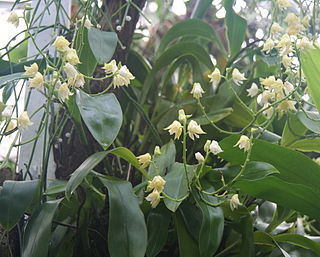
Polystachya, abbreviated Pol in horticultural trade, and commonly known as yellowspike orchid, is a flowering plant genus in the orchid family (Orchidaceae). This rather distinctive genus was described by William Jackson Hooker in 1824 and is the type genus of the subtribe Polystachyinae. It contains about 100 species widespread across many of the tropical areas of the world.

Orthochilus is a genus of orchids that consists of at least 34 species, most of which are native to Africa and Madagascar with a few species in tropical and subtropical America. The genus was first formally described in 1850 by the French botanist Achille Richard, who cited an earlier suggestion by the German botanist Christian Ferdinand Friedrich Hochstetter. Richard recognized a single species, Orthochilus abyssinicus, and noted that the genus shared many features with the closely related genus Eulophia, but differed from it in the form of the pollen masses and caudicule, a stalk to which the pollen masses are attached. The genus Orthochilus has often been viewed as a synonym of the larger genus Eulophia by many botanists, but a recent molecular phylogeny published in 2014 revealed that Eulophia, as traditionally circumscribed, was paraphyletic unless Orthochilus was recognized as a separate genus.

Eulophia speciosa is a species of terrestrial orchid found from Ethiopia to South Africa and in Yemen and Saudi Arabia. The plants usually grow in grasslands in sandy soils or in clay.

Brachycorythis is a genus of flowering plants from the orchid family, Orchidaceae. It contains approximately 40-50 species native mostly to Africa and Madagascar but also some from South and East Asia.
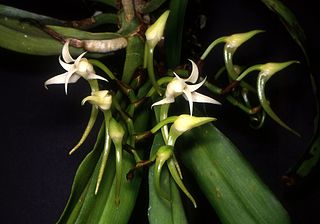
Cyrtorchis is a genus of flowering plants from the orchid family Orchidaceae native to Africa.

Diaphananthe is a genus of flowering plants from the orchid family, Orchidaceae. As currently conceived, it contains 33 accepted species, all endemic to sub-Saharan Africa.
Tridactyle is a genus of flowering plants from the orchid family, Orchidaceae. It has about 60-70 known species, all native to sub-Saharan Africa.
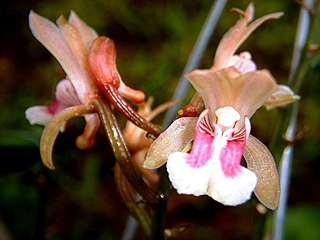
Oeceoclades, collectively known as the monk orchids, is a genus of flowering plants from the orchid family, Orchidaceae. It is related to Eulophia and like that genus is mostly terrestrial in habit. A few species extend into very arid environments, unusual for an orchid.

Peristylus, sometimes commonly known as ogre orchids or bog orchids is a genus of flowering plants from the orchid family, Orchidaceae. It consists of over 100 known species found across much of eastern and southern Asia as well as in Australia and on many islands of the Indian and Pacific Oceans.

Pterygodium is a genus of flowering plants from the orchid family, Orchidaceae. It found primarily in southern Africa but one species is endemic to Tanzania.

Schizochilus is a genus of flowering plants from the orchid family, Orchidaceae. It is native to southern and eastern Africa.

Angraecinae is a subtribe in the family Orchidaceae. The subtribe consists of approximately 47 genera. The type genus is Angraecum. Most of the genera are endemic to Africa, Madagascar and other Indian Ocean Islands, a few genera can also be found in the Americas.

Bonatea is a genus of orchids native to tropical and southern Africa, with one species extending into Yemen and Saudi Arabia.


















